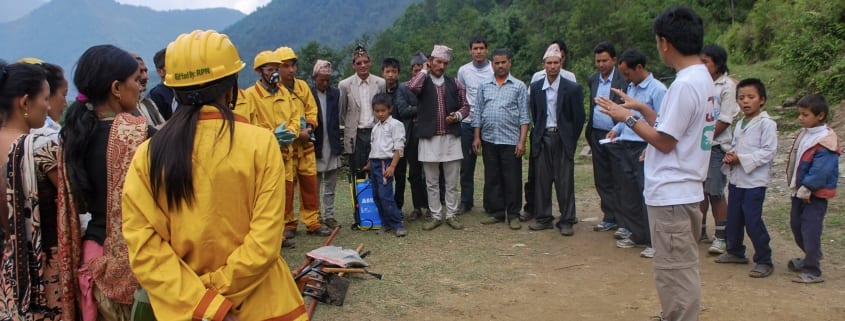Voices from the Rainforest: The Realities of Wildfire Management
Rainforest Trust projects thrive thanks to the important conservation work of people on the ground. Our Voices from the Rainforest series brings you news from our projects in Latin America, Africa, Asia and the Pacific — from the perspectives of those working in and for the rainforests.

Preparing for Wildfires through Community Based Forest Fire Management
The recent anthropogenic wildfire tragedies across the globe affect those on the ground the most. They witness this destruction of habitat first-hand, and in most cases, are burdened with finding the solutions to stop it.
Rainforest Trust spoke to Conservation Fellows Sonam Tashi Lama (STL) of Red Panda Network, Herman Michael Lyatuu (HML) of Tanzanian Forest Conservation Group and Jerónimo Vázquez Ramírez (JVR) of Pronatura Veracruz A.C. about their experiences and the impact these crises have on their work, and the world around them.

Sonam leading a fire management training course. Photo by Red Panda Network.
Do you have any training in forest fire crisis management?
STL: Yes, I attended courses during my undergrad degree about forest fire management in Nepal. Then when I started working with the community for Red Panda conservation in eastern Nepal, I trained users of the community forests on community-based forest fire management training. The training involved theory classes along with some practical sessions to handle tools and protective gears. In total, I have trained around 60 community forest members on such training.
JVR: Although “fire” is not an area/program in Pronatura Veracruz, we have some experience. Some of our staff are highly trained to direct combat fires in the field, to plan and execute fire protection actions to protect restored or protected areas and in the study of fire regimes in ecosystems.
Have you ever had exposure to out of control fires, either near your project site or elsewhere you have worked? If so, how were they controlled/resolved?
JVR: Yes, out of control fires as a consequence of human productive activities (agriculture and livestock mainly) are common in the area where we are implementing the project with Rainforest Trust as a partner, but also in other regions where we work (from mangroves to pine forests). In México, fires are fought with the collaboration of local communities, state and federal brigades and sometimes the army. Laws and committees have been established to address this topic in every state of the country. Together with the other stakeholders controlling actions are implemented.
HML: Yes, there was once a fire in my working area. I was informed of it by the local villagers, I asked them to help to fight it, and they did so.
How are you feeling concerning the news of wildfires overcoming tropical forests around the globe?
“The news about the tropical wildfires around the globes are depressing and devastating. The forest fires are not only destroying the tropical forests but destroying the home of the thousands of species.” – Sonam Tashi Lama, Nepal
HML: Fire is a big threat to tropical forests, it has the power to clear trees that have grown for 100 years within seconds. It destroys animals and their habitat.
Do you see a relationship between fires and climate change?
HML: Yes, I can see that it has a double effect. First, it clears trees that remove thermal gases from the atmosphere, like carbon. And second, it takes out the carbon that has been stored in the trees.
JVR: Yes, we think there is a direct relation between fires and climate change. Specifically, in the periodicity (as a consequence of prolonged dries fires are becoming more frequent) and intensity (as a consequence of fires in ecosystems that are not adapted like rainforests). It is important to clarify that although fires are becoming more frequent and more intense, 98% of the existing are originated from human activities (at least in México).
Short film by Pronatura Veracruz about the wildfires in Mexico.
What do you think are the best ways to prevent forest fires, apart from creating protected areas?
HML: Creating fire breaks around the area by clearing all combustible materials that will connect fire to the protected areas. Educate the community on the effects of forest fire/uncontrolled fire.
STL: One of the best ways to prevent forest fires is to train, engage and mobilize the local community people on forest fire management. The people from their own community could be the cause of the forest fire and thus working with the primary reason would be the best option. Secondly, education and awareness about the adverse effects of the forest fires with the local community will also be effective. In the Nepal context, the model of the community forest is working well on mitigating the incidents of forest fires as each and every member of the community are the watchdogs of their forest.
JVR: To prevent forests, it is necessary to fully understand its role in the ecosystems you are working on. Where the fire plays a natural role, the periodicity of fires should be determined and controlled fires could be started when the ecosystem requires it. On the other hand, where the fires are not beneficial for the ecosystems, direct protection activities should be implemented as firebreaks or pruning trees to prevent surface fires become crown fires.
Complementary to this, it is important to create capacities in local communities to prevent and fight fires, this way they can control and extinguish a fire when it starts or they will be able to protect their communities while the state brigades arrive. Besides, it is necessary to raise awareness and train farmers to prevent catastrophic fires initiated by their activities.

Sonam prepping community members on fire safety gear. Photo by Red Panda Network.
Header image: Sonam leading a community meeting. Photo by Red Panda Network.





